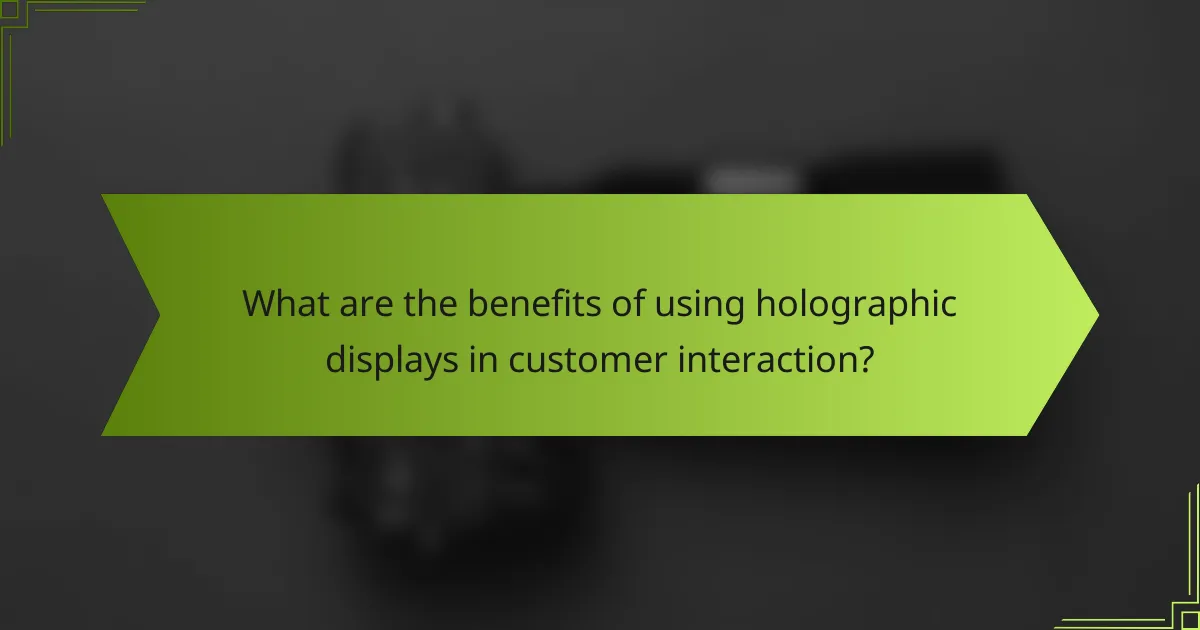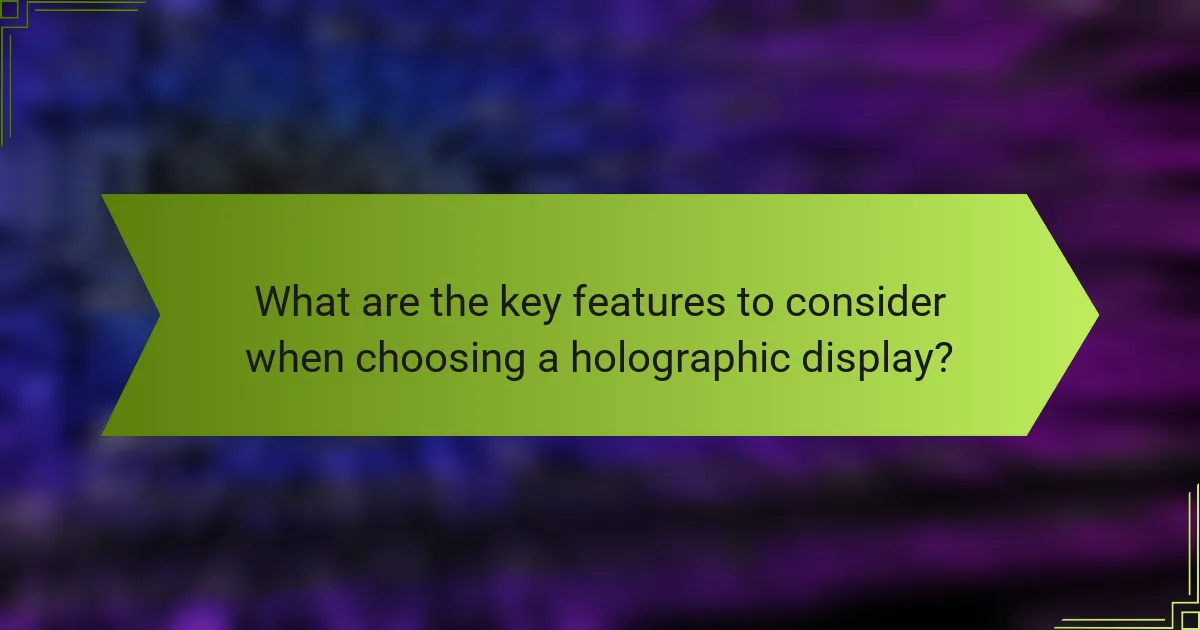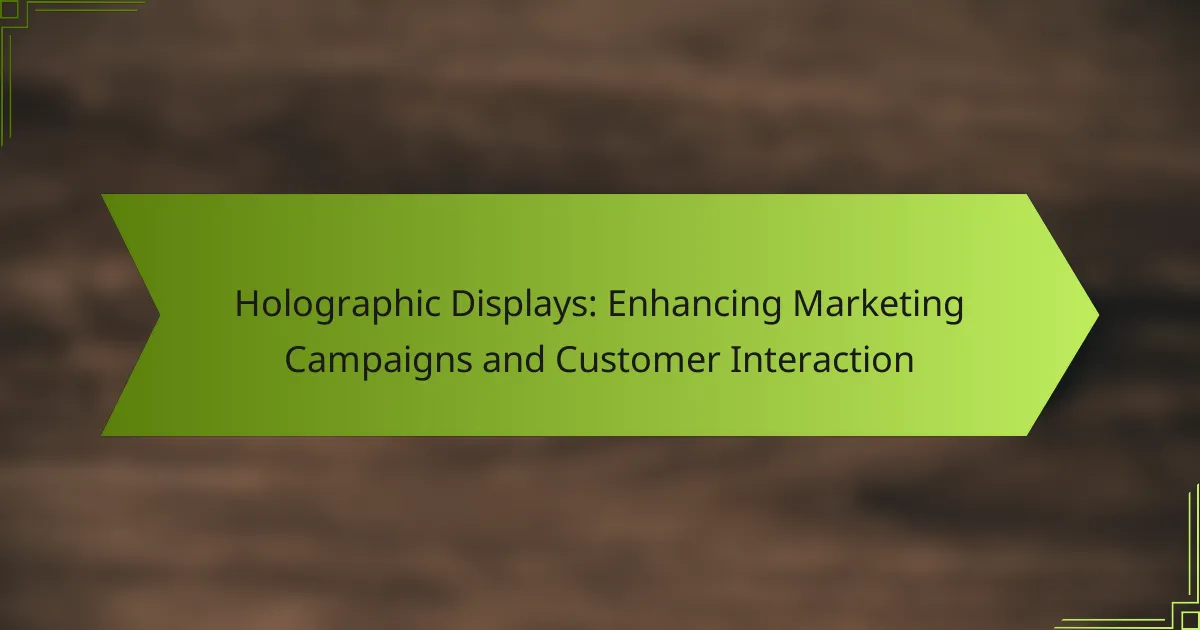Holographic displays are revolutionizing marketing campaigns by delivering captivating three-dimensional visuals that not only attract but also retain customer attention. By creating immersive experiences, these displays enable brands to communicate messages more effectively and foster deeper customer interactions, making products more memorable and engaging across various industries.

How can holographic displays enhance marketing campaigns?
Holographic displays can significantly enhance marketing campaigns by providing captivating visual experiences that attract and retain customer attention. These displays create three-dimensional images that engage viewers, making products more memorable and encouraging interaction.
Increased customer engagement
Holographic displays boost customer engagement by offering a unique and interactive way to showcase products. When customers can see a product in 3D and interact with it, they are more likely to spend time exploring features and benefits, leading to higher conversion rates.
For instance, retail stores using holographic displays can create immersive product showcases that draw in passersby, increasing foot traffic and interest in the brand.
Immersive brand experiences
Creating immersive brand experiences is essential for standing out in a competitive market. Holographic displays allow brands to tell their stories in a visually striking manner, enhancing emotional connections with customers.
By integrating holograms into events or pop-up shops, brands can create memorable experiences that resonate with audiences, encouraging social sharing and word-of-mouth promotion.
Real-time product visualization
Holographic displays enable real-time product visualization, allowing customers to see products from different angles and perspectives. This capability is particularly useful in industries like automotive or fashion, where details matter.
For example, a car dealership can use holograms to showcase various models, allowing customers to explore features without the need for physical inventory, thus saving space and resources.
Interactive advertising
Interactive advertising through holographic displays transforms passive viewers into active participants. By allowing customers to engage with the content, brands can create a more personalized experience.
For instance, a cosmetics brand might use a holographic display that lets customers virtually try on makeup, increasing the likelihood of purchase while providing a fun, engaging experience.
Data-driven insights
Holographic displays can also provide valuable data-driven insights into customer behavior. By tracking interactions with holographic content, brands can gather information on what captures attention and drives engagement.
This data can inform marketing strategies, helping brands refine their messaging and product offerings based on real customer preferences and behaviors, ultimately enhancing campaign effectiveness.

What are the benefits of using holographic displays in customer interaction?
Holographic displays significantly enhance customer interaction by providing immersive and engaging experiences. These displays allow brands to communicate their messages more effectively, create personalized experiences, and improve customer retention through innovative visual storytelling.
Enhanced communication
Holographic displays facilitate enhanced communication by presenting information in a visually striking manner. This technology captures attention and can convey complex messages quickly, making it easier for customers to understand product features or brand values.
For instance, a retail store might use a holographic display to showcase a new product’s features in 3D, allowing customers to see the item from various angles. This interactive approach can lead to better engagement and a clearer understanding of the product.
Personalized experiences
Personalization is key in modern marketing, and holographic displays can tailor experiences to individual customers. By integrating data analytics, brands can create customized holographic content that resonates with specific audience segments.
For example, a cosmetics brand could use holographic displays to show personalized makeup tutorials based on a customer’s skin tone and preferences. This level of customization enhances customer satisfaction and encourages repeat visits.
Improved customer retention
Utilizing holographic displays can lead to improved customer retention by creating memorable experiences that encourage loyalty. When customers have unique interactions with a brand, they are more likely to return and recommend the brand to others.
To maximize retention, businesses should regularly update holographic content to keep it fresh and relevant. Engaging customers with new holographic campaigns or seasonal promotions can maintain interest and foster a lasting relationship with the brand.

Which industries benefit most from holographic displays?
Holographic displays are particularly advantageous for industries that prioritize visual engagement and customer interaction. Retail, automotive, healthcare, and real estate are among the sectors leveraging this technology to enhance marketing efforts and improve customer experiences.
Retail and e-commerce
In retail and e-commerce, holographic displays create immersive shopping experiences that attract customers. For instance, brands can showcase products in 3D, allowing consumers to visualize items from multiple angles before making a purchase.
Implementing holograms can increase customer engagement by up to 40%, making it a powerful tool for driving sales. Retailers should consider integrating holographic displays in store windows or as part of online platforms to enhance product visibility.
Automotive
The automotive industry benefits from holographic displays by providing interactive product demonstrations and virtual showrooms. Customers can explore vehicle features and customizations through 3D representations, making the buying process more engaging.
Automakers can use holograms at trade shows or dealerships to highlight new models and technologies. This approach not only captures attention but also helps potential buyers make informed decisions more quickly.
Healthcare
In healthcare, holographic displays are used for patient education and surgical planning. Medical professionals can present complex information in a visually accessible manner, improving patient understanding of procedures and conditions.
Moreover, surgeons can utilize holograms to visualize anatomy during operations, enhancing precision and outcomes. Hospitals should explore partnerships with tech firms to develop tailored holographic solutions that meet specific medical needs.
Real estate
Real estate agents leverage holographic displays to offer virtual property tours, allowing potential buyers to explore homes remotely. This technology provides a realistic sense of space and design, which can be crucial in decision-making.
Using holograms can reduce the time properties spend on the market by attracting more interest. Agents should consider incorporating this technology into their marketing strategies to stand out in a competitive market.

What are the key features to consider when choosing a holographic display?
When selecting a holographic display, consider factors such as display resolution, size and scalability, and interactivity options. These features significantly impact the effectiveness of the display in marketing campaigns and customer engagement.
Display resolution
Display resolution is crucial for producing clear and detailed holographic images. Higher resolutions, typically ranging from 1080p to 4K, provide sharper visuals, enhancing viewer experience and engagement. A display with lower resolution may result in pixelation, which can detract from the overall impact of your marketing message.
When evaluating resolution, consider the viewing distance. For close-range displays, higher resolutions are essential, while lower resolutions might suffice for displays viewed from a distance. Always aim for the best resolution that fits your budget and application needs.
Size and scalability
The size of the holographic display affects its visibility and impact in various environments. Larger displays can capture more attention, making them suitable for events or storefronts, while smaller displays may work better for personal devices or interactive kiosks. Assess the space where the display will be used to determine the optimal size.
Scalability is also important, especially for businesses planning to expand their marketing efforts. Choose a display that can be easily integrated into larger setups or multiple units without significant additional costs. This flexibility allows for future growth and adaptation to changing marketing strategies.
Interactivity options
Interactivity options enhance customer engagement by allowing users to interact with the holographic content. Features like touch response, gesture control, and voice commands can create a more immersive experience. Consider what level of interactivity aligns with your marketing goals and customer expectations.
When selecting interactivity features, ensure they are user-friendly and intuitive. Overly complex systems may frustrate users and reduce engagement. Testing different options with your target audience can provide valuable insights into which interactive elements resonate best.
